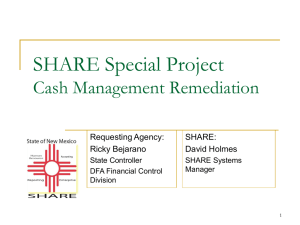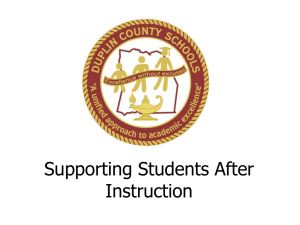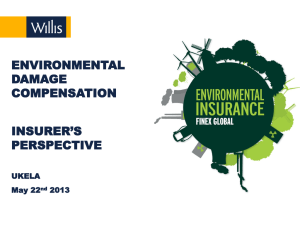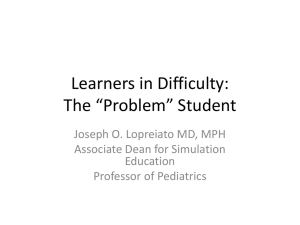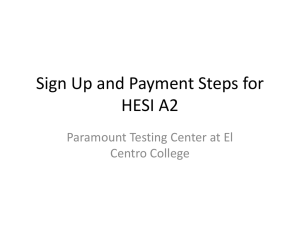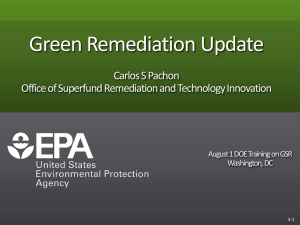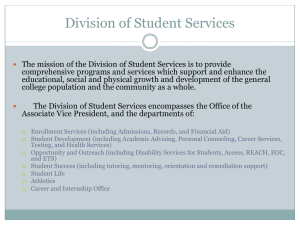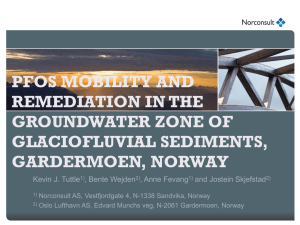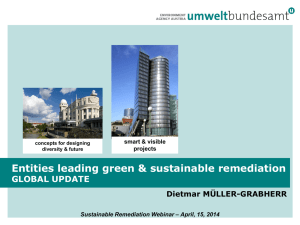Brownfields Road Map, 5th Edition Overview of the Proposed - CLU-IN
advertisement
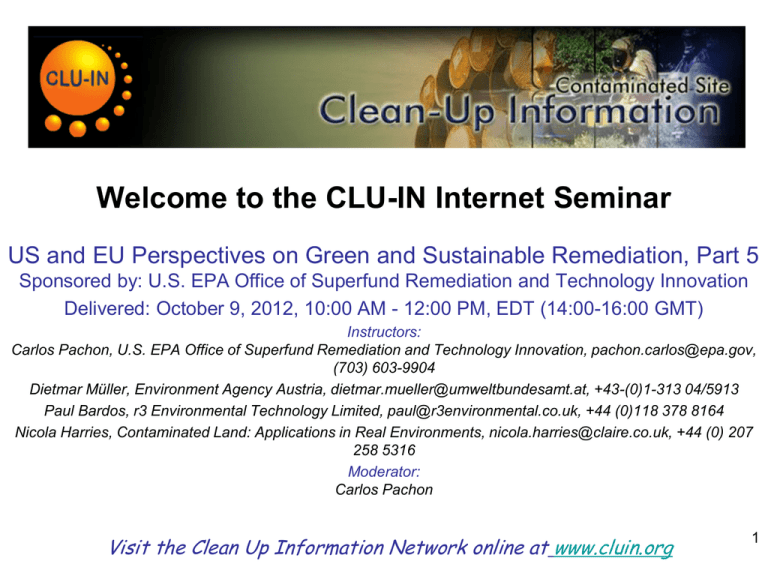
Welcome to the CLU-IN Internet Seminar US and EU Perspectives on Green and Sustainable Remediation, Part 5 Sponsored by: U.S. EPA Office of Superfund Remediation and Technology Innovation Delivered: October 9, 2012, 10:00 AM - 12:00 PM, EDT (14:00-16:00 GMT) Instructors: Carlos Pachon, U.S. EPA Office of Superfund Remediation and Technology Innovation, pachon.carlos@epa.gov, (703) 603-9904 Dietmar Müller, Environment Agency Austria, dietmar.mueller@umweltbundesamt.at, +43-(0)1-313 04/5913 Paul Bardos, r3 Environmental Technology Limited, paul@r3environmental.co.uk, +44 (0)118 378 8164 Nicola Harries, Contaminated Land: Applications in Real Environments, nicola.harries@claire.co.uk, +44 (0) 207 258 5316 Moderator: Carlos Pachon Visit the Clean Up Information Network online at www.cluin.org 1 Housekeeping • Please mute your phone lines, Do NOT put this call on hold – press *6 to mute #6 to unmute your lines at anytime • Q&A • Turn off any pop-up blockers • Move through slides using # links on left or buttons Download slides as PPT or PDF Go to slide 1 Move back 1 slide Move forward 1 slide Go to last slide Go to seminar homepage Submit comment or question Report technical problems • This event is being recorded • Archives accessed for free http://cluin.org/live/archive/ 2 US and EU Perspectives on Green and Sustainable Remediation, Part 5 9 October, 2012 3 Agenda • Advancing Remediation Global Exchange: A Track Record – Dietmar Müller, Environment Agency Austria • Overview of Conceptual Frameworks Discussions – Nicola Harries, Contaminated Land: Applications in Real Environments (CL:AIRE) • Overview of Sustainability Assessment Discussions – Carlos Pachon, U.S. EPA Office of Superfund Remediation and Technology Innovation • Overview of Sustainability Management Discussions – Paul Bardos, r3 environmental technology ltd • Discussion/Question & Answer Session The 2nd International Conference on Sustainable Remediation 2012 November 14 – 16, 2012 in Vienna, Austria www.umweltbundesamt.at/sustainable_remediation2012 US and EU Perspectives on Green and Sustainable Remediation, Part 5 – 10/09/12 4 Advancing Remediation Global Exchange: A Track Record Dietmar Müller, Environment Agency Austria 5 Advancing Remediation Global exchange: A Track Record 2009 Green Remediation Conference (Copenhagen, DK) • see www.eugris.info/newsdownloads/GreenRemediation/ 2010 ConSoil (September 21 – 24; Salzburg, AT) – US and EU perspectives - Internet Seminar Part 1 (July 12, 2010) 2011 10th ICCL-meeting (October 4 – 6; Washington, USA) • US and EU perspectives - Internet Seminar 2 & 3 (March 15 & October 26, 2011) 2012 SustRem 2012 (November 14 – 16; Vienna, AT) • US and EU perspectives - Internet Seminar 4 & 5 (March 6 & October 9, 2012) FOR MATERIALS WATCH OUT: www.clu-in.org/global US and EU Perspectives on Green and Sustainable Remediation, Part 5 – 10/09/12 6 Green Remediation 2009 (Copenhagen, DK) REFRAMING for Informed Decisions CONCEPTUAL FRAMEWORK • SuRF UK • NICOLE PRACTICAL TOOLS • simple indicators (e.g. carbon footprint, specific energy use) • complex environmental accounting/balance • environmental balance & organising stakeholder discourse METRICS • Carbon footprint – use simple things creating impacts • environmental footprints – organising complex information to provide the complete picture 7 Green Remediation 2009 (Copenhagen, DK) Improving Technology Implementation Greening Remediation adapting and contributing to CO2- and energy-saving minimizing the environmental footprint Practicing Synergies risk management-recycling-renewables organised at regional scales optimizing engineered solutions and “working with nature” Sustainable/Green Technologies not a single technology but a fan/variety of technologies identify typical routine applications time frames a driver for cost & environmental side-effects 8 Green Remediation 2009 (Copenhagen, DK) How to Follow Up? further international exchange: •watching out and establishing “market places of ideas” •Organizing information (EUGRIS, CLU-IN) “Greening” international exchange (saving $, time & CO2) • internet seminars To spread the word: • CONSOIL 2010 ! • 2nd Sustainable Remediation Conference ? 9 ConSoil 2010 (Salzburg, AT) Sustainable Remediation (SpS 8A) Special Session 8A: International Developments •Draft White paper “Sustainable and Green Remediation” Sustainable Remediation: ‘Integrating environmental, social, and economic factors to maximize the net benefit of all three in a balanced way. Sustainability cannot be measured in absolute sense’ Green remediation: ‘minimizing the environmental footprint; integrating environmental beneficial practices; requires transparency’ •state of implementation of sustainable remediation •Contributing: –USEPA; Environment Canada; SuRF US, SuRF UK, SuRF NL, and SURF Australia; EURODEMO+; NICOLE; and the Common Forum. US and EU Perspectives on Green and Sustainable Remediation, Part 5 – 10/09/12 10 ConSoil 2010 (Salzburg, AT) Sustainable Remediation (SpS 8B) Sp. Session 8B: Case Studies – Does it make a difference? •Introduction by a local case study – – – – – reduction waste production ~ 400.000 t or 28 % of the total mass savings, e.g. 14.000 trucks or 8 Mio. km risk reduction goals achieved challenge: regulatory constraints & stakeholder dialogue •Case studies from the US, UK and Australia – either remedy selection or during implementation of site remediation – information on particular constraints given by regulatory frames or within participatory processes US and EU Perspectives on Green and Sustainable Remediation, Part 5 – 10/09/12 11 10th ICCL-meeting (Washington D.C., USA, 2011) International Committee on Contaminated Land Integrating Contaminated Site Remediation & Reuse Strategies •Session A: 6 presentations & break out sessions Core questions: Current state of practice in your country/organisation? Challenges for the future in your country/organisation? Opportunities to address challenges in the future? Improve the participatory process Expand technical options to reduce cleanup footprints Learn from fellow peers how to establish a quantitative approach to sustainability Adopt full suite of regulatory, policy, incentive tools, etc. to foster sustainable cleanup US and EU Perspectives on Green and Sustainable Remediation, Part 5 – 10/09/12 12 US and EU perspectives Internet Seminar Part 5 (March 6, 2012) October 9, 2012) Case studies & Updates Greening Superfund Cleanups, Apache Powder Project, Arizona Andria Benner, U.S EPA Region 9 Remedial Project Manager TRIANGLE Zatec (Czech Republic) Jan Vaněk, DEKONTA Austria’s New MCEA-Tool Moritz Ortmann, Kommunalkredit Public Consulting GmbH Gernot Döberl, Environment Agency Austria Werner Frühwirth, denkstatt GmbH EPA Greener Cleanup Developments Carlos Pachon Updates on International Initiatives Paul Bardos, r3 Environmental Technology Limited (UK) 13 Sustainable Remediation 2012 (November 14 – 16, 2012; Vienna, AT) Wednesday, November 14 (1 – 6 p.m.) •Conceptual Frameworks (2 Sessions) – Welcome Reception Thursday, November 15 •Sustainability Assessment (2 Sessions; 9:30 a.m. – 1 p.m.) •Sustainability Management (2 Sessions; 2:15 – 6 p.m.) •Accompanying Scientific and Thematic Workshops Friday, November 15 •Sustainability Management (2 Sessions; 9 a.m. – 1 p.m.) •Round Table Discussion: "Green vs Sustainable - Opposing or Complimentary Perspectives on Remediation" US and EU Perspectives on Green and Sustainable Remediation, Part 5 – 10/09/12 14 Sustainable Remediation 2012 (November 14 – 16, 2012; Vienna, AT) Thursday, November 15 Scientific Workshops •GREENLAND: Gentle soil remediation technologies • (2 Sessions; 9:30 a.m. – 1 p.m.) •Producing Biomass on Brownfields –Selection of Most Sustainable Approaches: The REJUVENATE Project – (2 Sessions; 2:15 – 6 p.m.) Network Workshops •SuRFING the globe (9:30 – 11 a.m. ) •NICOLE (11:30 – 1 p.m.) US EPA Seminar : “Green Remediation“ (2:15 – 3:45 p.m.) US and EU Perspectives on Green and Sustainable Remediation, Part 5 – 10/09/12 15 Overview of Conceptual Frameworks Discussions Wednesday, November 14 (1 – 6 p.m.) Nicola Harries, Contaminated Land: Applications in Real Environments (CL:AIRE) 16 Conceptual Frameworks • Eight Papers in Total in this section • Presentations from across the globe from UK (2), USA(3), Australia, Flanders Belgium and Germany • Descriptions of the way their countries are embracing or starting to embrace Sustainable Remediation • Presentations fall into three categories: Established National Frameworks and work so far – SuRF- UK , USEPA & SURF (USA). Development of National Frameworks – Australia, Flanders Belgium and Germany Case Studies using already existing systems in UK and USA US and EU Perspectives on Green and Sustainable Remediation, Part 5 – 10/09/12 17 Papers 1. Building a Common Understanding on Sustainable Remediation – Jonathan Smith, Shell Global Solutions, SuRFUK 2. Protecting Human Health & the Environment with a Lower Environmental Footprint: US EPA’s Experience to Date Carlos Pachon, US EPA 3. United States Sustainable Remediation Forum Technical Initiatives – Whole System Sustainability Thinking for Optimal Decision Making – Karin Holland, Haley & Aldrich 4. A National Remediation Framework for Australia – Bruce Kennedy, CRC Care Australia US and EU Perspectives on Green and Sustainable Remediation, Part 5 – 10/09/12 18 Papers 5. Green and Sustainable Remediation in Flanders – Nick Bruneel, OVAM, Belgium 6. An approach Towards Sustainable Soil and Groundwater Remediation in Germany : State of the Art Report – HansPeter Koschitzky, University Stuttgart, Germany 7. Embedding the Assessment of Sustainability into Decision Making in the Delivery of National Grid Property’s Land Remediation Programme – Naomi Regan, National Grid 8. One Government Greener Cleanups on Military Land Collaboration – Barbara Maco, US EPA US and EU Perspectives on Green and Sustainable Remediation, Part 5 – 10/09/12 19 Presentation 1: Building a Common Understanding • Presented by Jonathan Smith, Shell Global Solutions and SuRF-UK Chairman • Presenter will give a brief overview of the history of Sustainable Remediation UK (SuRF-UK) and the work that they have carried out since 2007 and how SuRF-UK work is being used to build a common understanding in sustainable remediation. • He will describe the framework, the goals of the framework and the subsequent indicators that has been developed and how this work is now being built on by developing further guidance and a series of case studies. The framework is sufficiently generic that it can be used elsewhere. US and EU Perspectives on Green and Sustainable Remediation, Part 5 – 10/09/12 20 Presentation 1: Building Common Understanding • He will explain how the principles of sustainable remediation are embraced in UK best practice guidance and legislation and the framework helps deliver this. • He will indicate SuRF-UK has a track record in sharing and exchanging knowledge with related interested parties in other countries . Its work has been influential in sustainable remediation initiatives worldwide, including Australia, Canada the USA and in Europe the contaminated land network, NICOLE. • All helping to build a common understanding US and EU Perspectives on Green and Sustainable Remediation, Part 5 – 10/09/12 21 Presentation 2: US EPA’s Experience to Date • Presented by Carlos Pachon, US EPA • The presenter will describe the EPA’s policy, program management and technical tools that they have developed to advance the concepts of green remediation • He will share some of the experiences at a national and Superfund Program level, as well as specific site cleanup projects where environmental footprints have been addressed. US and EU Perspectives on Green and Sustainable Remediation, Part 5 – 10/09/12 22 Presentation 2: US EPA’s Experience to Date • He will explain that the EPA’s goal is to clean up contaminated sites to protect human health and the environment and enable communities and other stakeholders to pursue future beneficial use or reuse of resources for economic, environmental, and societal purposes. • From their experiences they have learned that they can implement protective cleanups that are greener by increasing their understanding of their environmental footprint and, when appropriate, take steps to minimize that footprint. US and EU Perspectives on Green and Sustainable Remediation, Part 5 – 10/09/12 23 Presentation 3: SURF USA Current Technical Initiatives • Presented by Karin Holland, President of SURF • Presenter will give a brief description of SURF USA, its history and its achievements from 2006 to today. • Focusing on the most recent 2012 technical initiatives which include: Development of a Perspectives Paper on the Integration of Sustainable Remediation and Sustainable Development Publishing the results of a study that describes and categorises existing sustainable remediation resources and tools. US and EU Perspectives on Green and Sustainable Remediation, Part 5 – 10/09/12 24 Presentation 3: SURF USA Current Technical Initiatives (cont.) • The presentation will describe how SURF USA has developed three overarching themes for all its technical initiatives in 2012 which are: How can SURF help practitioners better conserve water resources during remediation How can SURF better collaborate with other groups both nationally and internationally to develop and implement technical initiatives How can SURF assist practitioners to rate the sustainability of their remedial projects to align with other systems • Describe how these themes aim to guide and target SURF USA technical initiatives going forward as practices advance. • The presenter will finish by sharing SURF USA vision for the future. US and EU Perspectives on Green and Sustainable Remediation, Part 5 – 10/09/12 25 Presentation 4: A National Remediation Framework, Australia • Presented by Bruce Kennedy, CRC CARE • The presenter will provide an overview of the drivers for a national framework, the principal objectives to develop a framework, the delivery mechanism for the development and its requirements. • Provide an overview of the drivers such as: Description of the regulatory system in Australia – Federal and State Government What a national framework is expected to satisfy – harmonisation and enhancing standards of practice across the whole country. US and EU Perspectives on Green and Sustainable Remediation, Part 5 – 10/09/12 26 Presentation 4: A National Remediation Framework, Australia • Delivery Mechanism for framework development CRC CARE working closely with new Inter-Governmental body to help with harmonisation. • Describe what are the requirements of the framework Through stakeholder workshops Setting up of steering group • Outcomes and Progress to date Long term project through staged approach, the presenter will share where they are to date and what is planned for the future. Aim to deliver an accepted national remediation framework which incorporates practical guidance based on the need to operate in a sustainable fashion. US and EU Perspectives on Green and Sustainable Remediation, Part 5 – 10/09/12 27 Presentation 5: Green and Sustainable Remediation, Flanders • Presentation will be provided by Nick Bruneel OVAM • Presenter will provide details on the role and responsibilities of OVAM and how they are embracing sustainable remediation practices and their current work. • The presentation will explain how they differentiate between green and sustainable remediation and will share in more detail the research work that they are currently undertaking in both areas. Green Remediation – focuses on the technological aspects of soil remediation approach Sustainable Remediation – considers the land use and long-term planning as well US and EU Perspectives on Green and Sustainable Remediation, Part 5 – 10/09/12 28 Presentation 5: Green and Sustainable Remediation, Flanders • Green Remediation Literature Reviews of the application of life cycle analysis and calculation of CO2 emissions of soil remediation projects Introduction of CO2 calculator in the multi-criteria analysis for the BATNEEC evaluation of soil remediation projects • Sustainable Remediation Development of indicators based on SuRF-UK Indicators suitable for Flemish situations and case study developments Stimulation of the combination of groundwater remediation and heat storage. US and EU Perspectives on Green and Sustainable Remediation, Part 5 – 10/09/12 29 Presentation 6: State of the Art report, Germany • Presentation will be provided by Dr Hans-Peter Koschitzky of VEGAS, University of Stuttgart • The presentation aims to provide a summary of the different discussions that are occurring in Germany in relation to sustainability in soil and groundwater remediation projects with different stakeholder groups including consultants, regulators and problem holders. • The aim of the discussions is to come to a consensus and implement all sustainability aspects within a regulatory framework. US and EU Perspectives on Green and Sustainable Remediation, Part 5 – 10/09/12 30 Presentation 6: State of the Art report, Germany • Discussions include defining “sustainable remediation” • How sustainability should be evaluated • Looking at other international approaches and criteria sets that can be transposed to German remediation practices • The presentation will summarise the work to date and present the state of the art of the sustainability discussions with respect to soil and groundwater remediation in Germany and the integration of international views and experiences. US and EU Perspectives on Green and Sustainable Remediation, Part 5 – 10/09/12 31 Presentation 7: Embedding Sustainability into Decision Making • Presentation will be given by Naomi Regan of National Grid Property Ltd UK, she is also a member of SuRF-UK Steering Group. • The presenter will provide an example of how National Grid Property Holdings (NGPH) has adopted and further developed the SuRF-UK framework to produce a practical methodology to allow it to optimise the sustainability of remediation projects when dealing with its land portfolio. • The case study will show how they have interpreted the 15 SuRF-UK indicators and produced sub-indicators which apply to NGPH. US and EU Perspectives on Green and Sustainable Remediation, Part 5 – 10/09/12 32 Presentation 7: Embedding Sustainability into Decision Making • The presenter will then demonstrate the different phases of work and how they have concentrated on the development of a simple qualitative tiered analysis. • It is anticipated that the development of this tiered approach will provide transparent communication and decision making which is part of the fundamental principles which underpin the work of SuRF-UK. US and EU Perspectives on Green and Sustainable Remediation, Part 5 – 10/09/12 33 Presentation 8: US Government Greener Cleanups on Military Land • Presentation by Barbara Maco of the US Environmental Protection Agency • The presenter will share how the EPA and Air Force has recently signed a MoU to collaborate and conduct environmental footprint analyses to support green ups at Airforce installations in US Pacific Southwest Region. • The presentation will also demonstrate how the Air Force and EPA are implementing a “one government” approach to lever and share resources which reduces costs and improves environmental and energy performances. US and EU Perspectives on Green and Sustainable Remediation, Part 5 – 10/09/12 34 Presentation 8: US Government Greener Cleanups on Military Land • The EPA and Air Force have formed an inter-agency project team who will undertake joint pilot studies to develop interagency strategies to support and expand greener clean up practices at other Air Force sites throughout the US . • They will look at the use of lifecycle analyses approached • Develop best practices – water reuse, alternative energy source • Evaluate existing cleanup actions to see if they could reduce the environmental footprints of clean up. US and EU Perspectives on Green and Sustainable Remediation, Part 5 – 10/09/12 35 Key Messages • Sustainable Remediation is now being addressed globally • Series of presentations show that countries are at different stages of evolution, but there is a strong linkage to already established more highly developed frameworks such as SuRFUK and people are keen to learn from others. • Finally in situations where frameworks are already developed they are looking to refine, share and work collaboratively to ensure wider stakeholder buy in. US and EU Perspectives on Green and Sustainable Remediation, Part 5 – 10/09/12 36 Overview of Sustainability Assessment Discussions Thursday, November 15 (9:30 a.m. – 1 p.m.) Carlos Pachon, U.S. EPA Office of Superfund Remediation and Technology Innovation 37 SUSTAINABILITY ASSESSMENT: Speakers (1) • Conceptual Site or Project Models for Sustainability Assessment. Paul Bardos, r3, United Kingdom. • Principles and considerations for multi-criteria analysis in sustainable remediation. Pär-Erik Bak, Swedish Geotechnical Institute. • SCORE: Multi-criteria analysis (MCA) for sustainability appraisal of remedial alternatives. Lars Rosen Chalmers University, Sweden. • A Sustainability Decision Support Tool for Site Remediation in Canada. Robert Noël-de-Tilly, Golder Associés Ltée, Canada. US and EU Perspectives on Green and Sustainable Remediation, Part 5 – 10/09/12 38 SUSTAINABILITY ASSESSMENT: Speakers (2) • Improved Multi-criteria Analysis in Remediation Plans in Flanders: Quantifying Sustainability by introduction of the CO2-footprint. Nele Bal, TAUW, Belgium. • Integrating sustainability into effectiveness assessment – Austria’s new MCEA-Tool. Moritz Ortmann, Kommunalkredit Public Consulting, Austria. • Targeted Design and Integrated Evaluation of Land Use Alternatives for Sustainable Brownfield Redevelopment. Sebastian Schädler, University Tübingen, Germany. • DOG, a methodology for making sustainable decisions in dealing with large scale contaminated groundwater. Hans Slenders, Arcadis, The Netherlands. US and EU Perspectives on Green and Sustainable Remediation, Part 5 – 10/09/12 39 SUSTAINABILITY ASSESSMENT: Themes (1) • Approaches to quantifying sustainability – Generating information relevant to decisions being made – Sustainability analyses do not replace risk assessment and management protocols – Applying sustainability policy in remediation projects – Benchmarking against other nations/programs • Project specific “tools” vs. broad conceptual frameworks – – – – – – Quantitative analysis only after simple screening found insufficient Effective communication User friendly tools and “actionable” information Action thresholds Transparency and monitoring Site specific US and EU Perspectives on Green and Sustainable Remediation, Part 5 – 10/09/12 40 SUSTAINABILITY ASSESSMENT: Themes (2) • Challenges in quantifying GSR in projects – Defining project scopes (spacial, temporal, activity) – Establishing baseline – Prioritizing and deciding across multiple among competing alternatives (aka Balancing or Weighting of criteria) – Scale, particularly minimum – Sustainability indicators (aka “core elements”) – Challenge of univariate sustainability parameter (GHG/CO2e) – Quantitative and non-quantitative – Free/shareware vs. proprietary tools – GSR Driver – environmental protection requirement or redevelopment US and EU Perspectives on Green and Sustainable Remediation, Part 5 – 10/09/12 41 SUSTAINABILITY ASSESSMENT: Looking Forward (1) • Currently Focusing on Refinements: – Expanding to include temporal scales, including improvements to environmental outcome – Gaining experience applying assessments, and taking action – Greater emphasis on regional and global footprints • General Consensus on Footprint Evaluation: – Expert opinion plays an important role – Anticipated land use plays a role – Evaluations can often be relatively simple, labor-intensive evaluations are more suitable for large or complicated sites or as “tipping points” for remedy selection or optimization – Help prioritize options and/or rank feasibilities US and EU Perspectives on Green and Sustainable Remediation, Part 5 – 10/09/12 42 Overview of Sustainability Management Discussions Thursday, November 15 (2:15 – 6 p.m.) Friday, November 16 (9 a.m. – 1 p.m.) Paul Bardos, r3 environmental technology ltd 43 Contents • Overview of titles • Selected examples US and EU Perspectives on Green and Sustainable Remediation, Part 5 – 10/09/12 44 Analysis • 16 papers spread over one afternoon and one morning, incl. 4 discussion periods • 7 countries: USA (3); Belgium (2); Denmark (1); NL (2); Sweden (2); Poland (1); UK (5) • Topics – Sustainability and remedy selection (3) – Technology advancements (6) – Implementation and decision-making case studies (9) US and EU Perspectives on Green and Sustainable Remediation, Part 5 – 10/09/12 45 Listing • Embedding sustainability in contaminated site management – experiences and case studies; ERM UK • Reducing Environmental Impact through Biological In Situ Enhanced reductive Dechlorination via Closed-Loop Groundwater Circulation at a German Site; Geosyntec Consultants, USA. • Innovative and Sustainable Remediation of Carbon Disulfide using In Situ Chemical Oxidation with Activated Persulfate; FMC, UK • Sustainable Remediation of a Dense Non-Aqueous Phase Liquid (DNAPL) using innovative in-situ surfactant flushing at a site in the UK; ERM UK US and EU Perspectives on Green and Sustainable Remediation, Part 5 – 10/09/12 46 Listing (2) • Green engineering of soil remediation in Bilthoven, TAUW, NL • Sustainable Remediation of a Manufacturing Facility Impacted by Chlorinated Solvents – Pilot Trial; Arcadis UK • Carbon Footprint Assessment of a Large Scale In-situ Thermal Treatment project performed at a Chlorinated Solvent site in the UK; ERM, UK • Environmental Optimisation of in situ thermal remediation using life cycle assessment (LCA); Technical University of Denmark US and EU Perspectives on Green and Sustainable Remediation, Part 5 – 10/09/12 47 Listing (3) • From Misery to Electric Energy: A Brownfield’s Success Story; Navistar Inc., USA. • Tailored and integrated approach to redevelopment of degraded megasites – case study of a post-military site; IETU, Poland. • Sustainable Reuse of Contaminated Groundwater: Experiences in Southern CA; Sullivan International Group, USA. • Sanergy a sustainable mix of groundwater energy and remediation? Arcadis, NL US and EU Perspectives on Green and Sustainable Remediation, Part 5 – 10/09/12 48 Listing (4) • Combing groundwater energy with remediation in Flanders: policy and practice; OVAM, Belgium • Evaluating Social Effects in Sustainability Appraisal of Remediation Alternatives; Chalmers University, Sweden. • Accounting for Social Aspects in Sustainable Brownfield Revitalisation: a review of current Decision Support Tools; VITO, Belgium. • Sweden. Assessment of economic project risks in remediation of contaminated land; NCC Construction, Sweden US and EU Perspectives on Green and Sustainable Remediation, Part 5 – 10/09/12 49 Example 1 • Embedding sustainability in contaminated site management – Experiences and case studies – describes a practical approach for embedding sustainability into contaminated site management that draws on UK (Surf UK) and European (NICOLE) guidance. – provides several examples of how sustainable remediation principles have been incorporated into contaminated site management at a number of sites in the UK US and EU Perspectives on Green and Sustainable Remediation, Part 5 – 10/09/12 50 Example 2 • Dechlorination via Closed-Loop Groundwater Recirculation at a German Site – Biological enhanced in situ reductive dechlorination (ERD) identified as cost-effective and potentially more environmentally sustainable alternative to an existing P&T – Projection of benefits based on pilot scale testing US and EU Perspectives on Green and Sustainable Remediation, Part 5 – 10/09/12 51 Example 3 • Evaluating Social Effects in Sustainability Appraisal of Remediation Alternatives – Describes a MCA-approach which includes assessment of impacts and risks in the ecological, economic and social domain – Emphasis on the process to identify relevant criteria in the social domain – Provides example of 4 criteria (equity, health & safety, cultural heritage, and local environmental quality & amenity) connected to case studies – Compares methods and evaluates methodological aspects US and EU Perspectives on Green and Sustainable Remediation, Part 5 – 10/09/12 52 Discussion/ Question & Answer Carlos Pachon, U.S. EPA Office of Superfund Remediation and Technology Innovation 53 Discussion/Question & Answer • Moderator to take your questions on the phone line and Internet. • Topics may include: – Are sustainability management and risk management in conflict? – Can the environmental footprint of remediation projects be reduced? – Will sustainability be widely accepted as a tool in remediation decision making? – How closely are sustainable remediation and regeneration related? US and EU Perspectives on Green and Sustainable Remediation, Part 5 – 10/09/12 54 Speaker Contact Information • Paul Bardos, r3 Environmental Technology Limited, paul@r3environmental.co.uk • Nicola Harries, Contaminated Land: Applications in Real Environments, nicola.harries@claire.co.uk • Dietmar Müller, Environment Agency Austria, dietmar.mueller@umweltbundesamt.at • Carlos Pachon, U.S. EPA Office of Superfund Remediation and Technology Innovation, pachon.carlos@epa.gov US and EU Perspectives on Green and Sustainable Remediation, Part 5 – 10/09/12 55 Resources • Green Remediation Web page on EPA's Hazardous Waste Clean-up Information (CLU-IN) Website – www.cluin.org/global • Green Remediation Web page on EPA’s CLU-IN Website – www.cluin.org/greenremediation • EUGRIS (European Groundwater and Contaminated Land Remediation Information System): portal for soil and water management in Europe – www.eugris.info • The 2nd International Conference on Sustainable Remediation 2012, November 14 – 16, 2012 in Vienna, Austria – www.umweltbundesamt.at/sustainable_remediation2012 US and EU Perspectives on Green and Sustainable Remediation, Part 5 – 10/09/12 56 Resources & Feedback • To view a complete list of resources for this seminar, please visit the Additional Resources • Please complete the Feedback Form to help ensure events like this are offered in the future Need confirmation of your participation today? Fill out the feedback form and check box for confirmation email. 57 New Ways to stay connected! • Follow CLU-IN on Facebook, LinkedIn, or Twitter https://www.facebook.com/EPACleanUpTech https://twitter.com/#!/EPACleanUpTech http://www.linkedin.com/groups/Clean-UpInformation-Network-CLUIN-4405740 58
